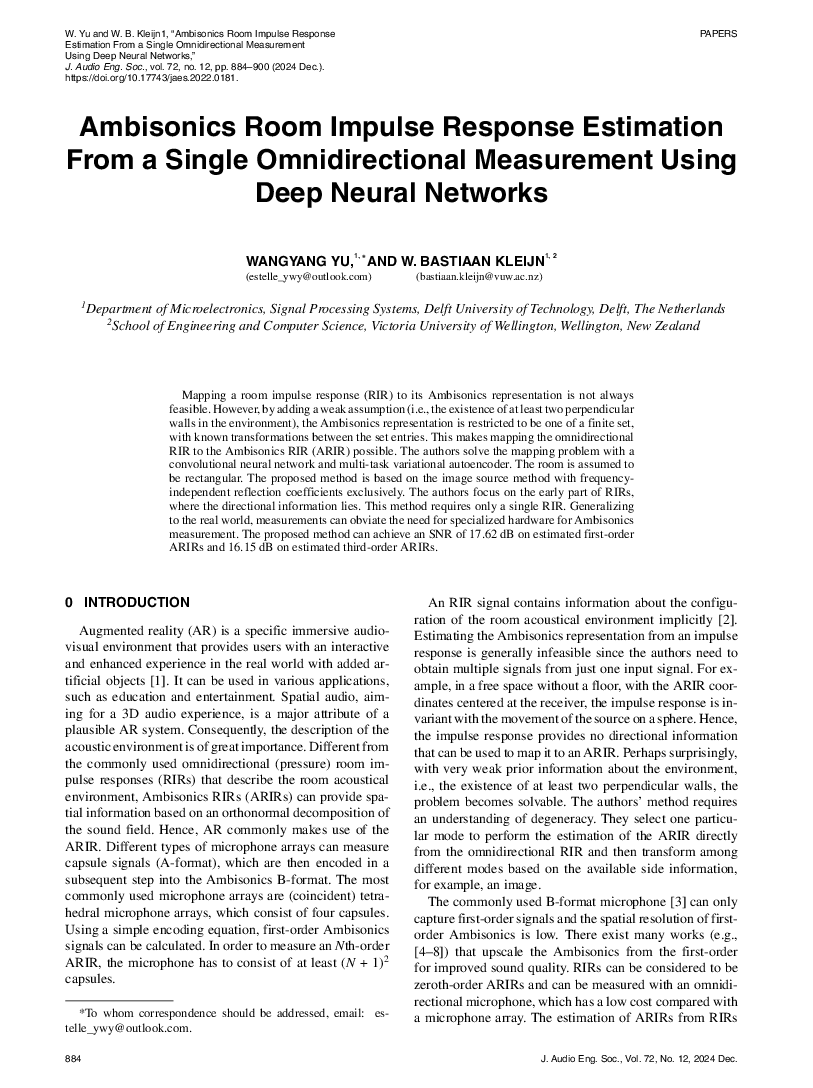Home / Publications / E-library page
You are currently logged in as an
Institutional Subscriber.
If you would like to logout,
please click on the button below.
Home / Publications / E-library page
Only AES members and Institutional Journal Subscribers can download
Mapping a room impulse response (RIR) to its Ambisonics representation is not always feasible. However, by adding a weak assumption (i.e., the existence of at least two perpendicular walls in the environment), the Ambisonics representation is restricted to be one of a finite set, with known transformations between the set entries. This makes mapping the omnidirectional RIR to the Ambisonics RIR (ARIR) possible. The authors solve the mapping problem with a convolutional neural network and multi-task variational autoencoder. The room is assumed to be rectangular. The proposed method is based on the image source method with frequency independent reflection coefficients exclusively. The authors focus on the early part of RIRs, where the directional information lies. This method requires only a single RIR. Generalizing to the real world, measurements can obviate the need for specialized hardware for Ambisonics measurement. The proposed method can achieve an SNR of 17.62 dB on estimated first-order ARIRs and 16.15 dB on estimated third-order ARIRs.
Author (s): Yu, Wangyang; Kleijn, W. Bastiaan
Affiliation:
Department of Microelectronics, Signal Processing Systems, Delft University of Technology, Delft, The Netherlands; School of Engineering and Computer Science, Victoria University of Wellington, Wellington, New Zealand
(See document for exact affiliation information.)
Publication Date:
2024-12-12
Import into BibTeX
Permalink: https://aes2.org/publications/elibrary-page/?id=22786
(1167KB)
Click to purchase paper as a non-member or login as an AES member. If your company or school subscribes to the E-Library then switch to the institutional version. If you are not an AES member Join the AES. If you need to check your member status, login to the Member Portal.

Yu, Wangyang; Kleijn, W. Bastiaan; 2024; Ambisonics Room Impulse Response Estimation From a Single Omnidirectional Measurement Using Deep Neural Networks [PDF]; Department of Microelectronics, Signal Processing Systems, Delft University of Technology, Delft, The Netherlands; School of Engineering and Computer Science, Victoria University of Wellington, Wellington, New Zealand; Paper ; Available from: https://aes2.org/publications/elibrary-page/?id=22786
Yu, Wangyang; Kleijn, W. Bastiaan; Ambisonics Room Impulse Response Estimation From a Single Omnidirectional Measurement Using Deep Neural Networks [PDF]; Department of Microelectronics, Signal Processing Systems, Delft University of Technology, Delft, The Netherlands; School of Engineering and Computer Science, Victoria University of Wellington, Wellington, New Zealand; Paper ; 2024 Available: https://aes2.org/publications/elibrary-page/?id=22786
@article{yu2024ambisonics,
author={yu wangyang and kleijn w. bastiaan},
journal={journal of the audio engineering society},
title={ambisonics room impulse response estimation from a single omnidirectional measurement using deep neural networks},
year={2024},
volume={72},
issue={12},
pages={884-900},
month={september},}